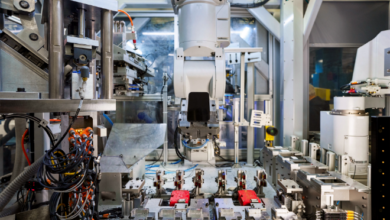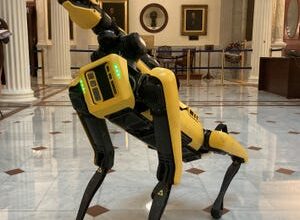Industrial Robotics Market Advancements Highlighted by Trends, Innovations, and Growth Outlook by 2030

The industrial robotics market stands at the forefront of revolutionizing global manufacturing landscapes, offering advanced automation solutions that enhance productivity, precision, and safety across diverse industries. Industrial robots, characterized by their versatility and efficiency, are integral components in modern manufacturing processes, performing tasks ranging from assembly and welding to material handling and quality inspection. As industries embrace automation to meet evolving demands for efficiency, quality assurance, and cost-effectiveness, the industrial robotics sector continues to experience rapid growth. This dynamic market is driven by technological innovations, rising labor costs, stringent quality standards, and the pursuit of operational excellence in a competitive global market.
The Industrial Robotics Market Size was valued at USD 25.45 billion in 2022 and is expected to reach USD 59.93 billion by 2030 and grow at a CAGR of 11.3% over the forecast period 2023-2030.
The industrial robotics market is experiencing robust growth, driven by automation trends across manufacturing industries worldwide. Industrial robots, ranging from articulated robots to collaborative robots (cobots), are integral in enhancing operational efficiency, precision, and safety in factory environments. As industries increasingly adopt automation to improve productivity and meet stringent quality standards, the demand for advanced robotics solutions continues to expand.
Download Sample Copy of Report: www.snsinsider.com/sample-request/1058
Top Key Players:
ABB, DÜrr, FANUC, YASKAWA, KUKA, Denso Corporation, Mitsubishi Electric, Kawasaki Heavy Industries, Universal Robots A/S, NACHI-FUJIKOSHI, Panasonic Corporation, Rockwell Automation, Inc., Bosch GmbH, Yaskawa Electric Corporation, Toshiba Corporation, Seiko Epson
Market Scope
The industrial robotics market encompasses a wide array of robotic systems and components used in manufacturing and production processes. These include robotic arms, end-of-arm tools (EOAT), sensors, controllers, and software for programming and integration. Key applications include assembly, welding, material handling, packaging, and inspection across automotive, electronics, healthcare, and other sectors. The market serves both large-scale manufacturers and SMEs looking to optimize production workflows.
Market Analysis
Globally, the industrial robotics market is segmented by type, application, industry vertical, and region. Types of industrial robots include articulated, SCARA, delta, Cartesian, and collaborative robots.
Applications range from pick-and-place operations to complex assembly tasks and hazardous material handling. Major industry verticals driving market growth include automotive, electronics, food and beverage, pharmaceuticals, and logistics. Geographically, Asia-Pacific leads the market, driven by extensive industrialization and automation initiatives, followed by North America and Europe.
Market Drivers
Key factors fueling the growth of the industrial robotics market include:
- Automation and Industry 4.0: The shift towards smart factories and Industry 4.0 principles drives demand for flexible, interconnected robotic systems.
- Labor Shortages and Cost Efficiency: Increasing labor costs and shortages prompt manufacturers to invest in robotics for repetitive and labor-intensive tasks.
- Quality and Precision Requirements: Growing emphasis on product quality, precision, and consistency fuels adoption of robotic automation in manufacturing.
- Safety and Ergonomics: Robotics enhance workplace safety by handling hazardous tasks and improving ergonomic conditions for workers.
Market Dynamics
The industrial robotics market dynamics are shaped by technological advancements, competitive pressures, regulatory frameworks, and evolving customer needs. Manufacturers focus on developing collaborative robots that work alongside humans, AI-driven robots for predictive maintenance, and cloud-based solutions for remote monitoring and control. Integration with IoT and AI technologies further enhances robot performance and operational efficiency in industrial settings.
Market Segmentation:
By Application
- Palletizing
- Assembling
- Welding
- Material Handling
- Painting
By Types
- 6-Axis Robots
- SCARA
- Cartesian
- Articulated
- Redundant
- Delta
- Dual-Arm and Parallel
By End-user
- Entertainment
- Electronics
- Automotive
- Rubber & Plastic
- Food & Beverage
- Pharmaceuticals
By Component
- Robotic Arms
- End Effectors
- Drive Units
- Robot Accessories
- Controllers
- Vision Systems
- Sensors
Market Opportunities
The industrial robotics market presents numerous growth opportunities:
- Emerging Technologies: Innovating with AI, machine learning, and advanced sensors to enhance robot capabilities and adaptability.
- Service Robotics: Expanding into service robotics for non-industrial applications such as healthcare, agriculture, and logistics.
- Global Expansion: Penetrating emerging markets with rising industrialization and automation investments.
- Partnerships and Collaborations: Collaborating with tech companies and system integrators to develop customized robotics solutions.
Market Key Factors
Critical success factors in the industrial robotics market include:
- Performance and Reliability: Delivering high-performance robots that meet stringent production requirements and uptime expectations.
- Safety Standards: Ensuring robots comply with international safety standards and regulations to mitigate workplace risks.
- Customer Support and Training: Providing comprehensive customer support, training programs, and maintenance services to optimize robot uptime.
- Innovation Leadership: Continuously innovating to stay ahead in a competitive market, offering differentiated solutions and superior value.
Complete Report: www.snsinsider.com/checkout/1058
Challenges
Despite growth prospects, the industrial robotics market faces several challenges:
- High Initial Costs: The upfront investment in robotic systems and integration can be prohibitive for some manufacturers.
- Complex Integration: Integrating robotics with existing production systems and workflows can be technically challenging and costly.
- Skills Gap: Shortage of skilled technicians and engineers proficient in robotics programming, maintenance, and troubleshooting.
- Ethical and Social Concerns: Addressing concerns about job displacement and ethical use of robotics in the workplace.
Conclusion
The industrial robotics market is poised for significant growth, driven by automation trends, technological advancements, and the pursuit of operational excellence in manufacturing. While challenges such as high costs and integration complexities exist, the market offers substantial opportunities for innovation and expansion. As industries continue to prioritize efficiency, safety, and quality, the adoption of industrial robotics is expected to accelerate, shaping the future of manufacturing worldwide.
News From
Category: Industry Reports & Market Analysis Profile: In the fast-paced business biospheres, businesses need to constantly evolve to grow and stay relevant. At SNS Insider, we believe in adopting a data-oriented approach to aid organizations be familiar with the nerve of the industry.
This email address is being protected from spambots. You need JavaScript enabled to view it.



